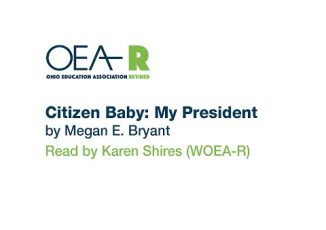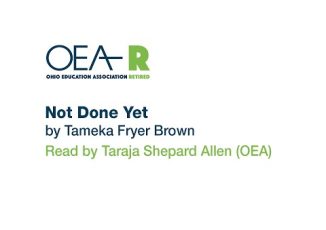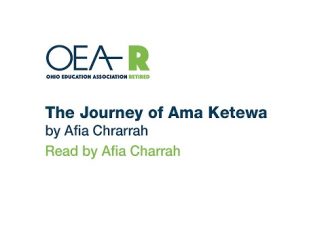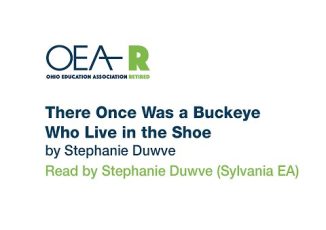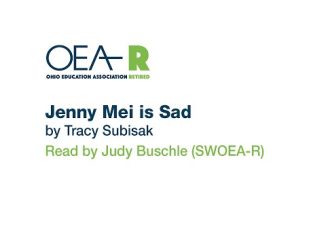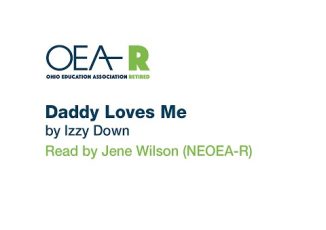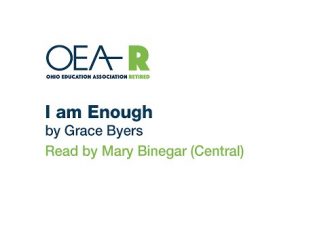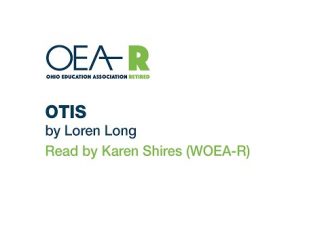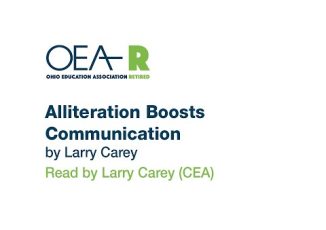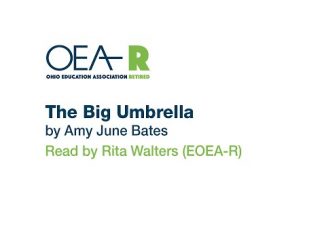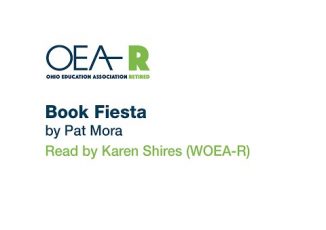OEA: ‘No excuses. Pass the Fair School Funding Plan now.’
“Every single student in Ohio deserves a world-class education, no matter where they live, what they look like, or how much money their families or their neighbors make. Ohio’s lawmakers have the once-in-a-generation chance right now to deliver on that promise, and the state has the resources to make it happen,” Ohio Education Association (OEA) President Scott DiMauro said. “The lawmakers who continue to push for a continuation of the status quo under the partisan Senate school funding plan were put on notice today: There is zero excuse not to fix our school funding system right now.”
The Fair School Funding Plan was developed over the last three and a half years through scores of public meetings and with input from school finance experts, educators, and community members. It has twice passed the Ohio House with wide bipartisan support and would provide a permanent, predictable formula to ensure all public school students in Ohio can get the resources they need to succeed while ending the state’s unconstitutional overreliance on local property taxes to fund our schools.
While critics of the Fair School Funding Plan have made misleading claims about the sustainability of the Fair School Funding Plan, confirmation from the Office of Budget and Management about the amount of funding available for the Fair School Funding Plan today makes those claims moot.
“Not only is there plenty of money in the state coffers to fully implement the Fair School Funding Plan for Ohio’s kids, there is enough to phase it in fully in this biennium, rather than over the next six years, removing just about any potential question marks about fully-phased in costs,” DiMauro said. “Even if they wait to fully fund it until next biennium, knowing what they know about the state’s flush finances, Ohio’s lawmakers should set aside the additional phase-in funding for future legislatures so there will be zero question in the next budget cycle about whether the revenue will be there to deliver for Ohio’s kids. They’ve waited too long for a school funding system that meets their needs; now, there is no reason they can’t have the fairly and fully funded schools they deserve.”
OEA Condemns Bills Seeking to Ban ‘Divisive Concepts’ in Ohio Schools
Ohio Education Association President Scott DiMauro released the following statement in opposition to House Bills 327 and 322, which both aim to ban Ohio’s public schools from teaching so-called “divisive concepts,” after hearings in the House State and Local Government Committee Tuesday morning:
“The Ohio Education Association (OEA) is disturbed, disappointed, and disheartened by recent efforts to white-out American history by hiding the truth from Ohio’s children – depriving them of the world-class, truth-based education they deserve. For our children to thrive and become critical thinkers, we must trust Ohio’s dedicated educators to have age-appropriate conversations about the tough subjects, as they do every day in their classrooms now. No matter where they come from or what they look like, our kids need a well-rounded, intellectually stimulating school curriculum that celebrates all of Ohio’s history, including the countless contributions made – and challenges faced – by people of color in our state. Over my 30-year career as a Social Studies teacher, I have seen for myself that when our kids learn from the past, they can help build a better future for all of us.
Instead, cynical political operatives seek to divide and distract us from their decades of failure to fix Ohio’s broken school funding system that has left so many communities behind. As Ohio’s House and Senate leaders work to finalize the next state budget, OEA continues to demand fully and fairly funded schools that have the resources to meet every child’s needs and a curriculum that nurtures every child’s curiosity and honors their integrity, whether they are Black or white, Latino or Asian, native or newcomer. Ohio’s educators know we can’t lie our way around the hard truths; our children can handle them, and they deserve nothing less.”
OEA Pathways Mentor Program
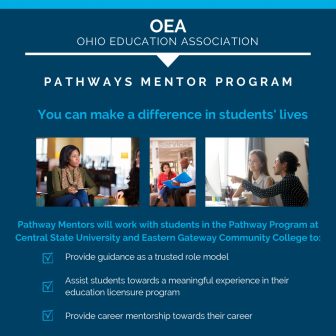
This Program is Not Accepting any Additional Applicants for 2022-2023
You can make a difference. in students’ lives
Pathway Mentors will work with students in the Pathways Program at Central State University and Eastern Gateway Community College to:
- Provide Guidance as a trusted role model
- Assist students towards a meaningful experience in their education licensure program
- Provide career mentorship towards their career
We want to help you become an Ohio change leader for the next generation.
New data, same old story: Vouchers hurt Ohio’s kids, taxpayers
KnowYourCharter.com was recently updated to include information specifically on the EdChoice Performance Based Vouchers (the only program that tracks voucher recipient test performance). Included in the new data is how much more reliant on local property taxes districts become due to the state diverting funding from public school children to these privately run schools. The Ohio Supreme Court ruled four different times that the state had to reduce property tax reliance. These voucher and charter school programs clearly have done the opposite.
Even more troubling is the new data indicates EdChoice is fueling so-called “White Flight” from Black and brown communities. Students taking vouchers are nearly twice as likely to be White as students in the districts where 95% of the money comes from that are subsidizing those students’ private school tuitions.
“The Ohio Education Association has long fought to shine the spotlight on how these vouchers are draining resources from the approximately 90 percent of Ohio students who attend public schools. The new Know Your Charter data clearly demonstrates what we’ve known all along,” OEA President Scott DiMauro said, expressing special concern for the “White Flight” problem EdChoice is fueling: “these same communities, which have already been failed by years of inequities under the state’s unconstitutional school funding system, are forced to go to the ballot more often for larger levy increases, even though only part of that money actually goes to their kids. It smacks of state-sanctioned segregation.”
This new data allows Ohioans to find out exactly how many students are “leaving” their district with these vouchers and exactly which private schools are receiving taxpayer funded tuition subsidies at the expense of their better-performing public school counterparts. In fact, the Cincinnati Enquirer revealed last year that nearly 90% of all voucher students do worse on state tests than students who attend public schools in the same communities. Despite this, Ohio lawmakers voted late last year to expand eligibility for the EdChoice voucher program and continue its explosive, decade-long growth.
Because there is not currently any direct funding system for the EdChoice performance-based voucher program, public districts must dig into their budgets to pay for the private school tuition of students. In some districts, EdChoice deducts more money per student than is actually provided by the state, so it forces the community to use local funding to offset those losses, creating real consequences like larger class sizes and reduced opportunities for public school students. And even in communities where the deduction is less than what students in the district receive, it forces those communities to rely more on local property taxes to pay for schools.
“To add insult to injury, a large portion of the students who receive EdChoice vouchers have never set foot in the public school that’s losing money to send them to a poorly-performing private institution. In fact, that’s the case for so many recipients, the Ohio Department of Education can’t even provide an overall demographic breakdown for voucher kids, because they’ve never had them in their tracking system,” DiMauro said. “It’s frankly a disgrace and Ohio’s public school children deserve so much better than this broken scheme. OEA is grateful that the Know Your Charter site is able to demonstrate the harm so plainly now.”
The Know Your Charter website still has information about charter school performance and funding, as well as the new voucher information.
DEADLINE EXTENSION: Students, educators can now enter Ohio Education Association’s redistricting contest through June 1, 2021
“These district maps play a fundamental role in the strength of our democracy, but for too long, gerrymandered districts have allowed politicians to choose their voters, not the other way around,” OEA President Scott DiMauro said. “Thanks to reforms approved by voters like requirements to keep 65 of Ohio’s 88 counties whole and only let five counties be split more than twice, the redistricting commission is being held to new standards to ensure districts are politically competitive and elected leaders must represent the interests of all of their constituents, not just their favored few. Ohio’s students and educators have a chance to show them how that’s done.”
The Design Ohio’s Future contest is open to all Ohio middle and high school students as well as all OEA members. Entrants can design their maps using the free community webtool at https://districtr.org/, click the ‘share’ button, and submit their map’s URL on the OEA website at https://www.ohea.org/design-ohios-future-contest/ Full contest rules are on the submission page. All entries are due no later than June 1, 2021.
Winners will be selected for creating Ohio House, Ohio Senate, and Congressional District maps in the following categories: Most Politically Competitive, Fewest Community Splits, and Most Creative. All map entries must include districts that have roughly the same population size and are contiguous, and all entries except those in the Most Creative categories must adhere to redistricting requirements Ohioans voted for. The full requirements and a tutorial video can be found on the Design Ohio’s Future page of the OEA website.
A middle school student, high school student, and OEA member winner will be chosen in each of the nine categories. The winners will receive a special commemorative plaque and have their maps featured in the Ohio Schools magazine and on the OEA and All in for Equal Districts websites. The maps will also be shared with the state officials responsible for redrawing Ohio’s maps.
“What happens in our classrooms depends so much on what happens in our Capitol buildings,” DiMauro said. “Our current system is broken, and if we’re going to fix this mess, we need non-partisan, independent redistricting that ends map manipulation. We’re asking Ohio’s students and educators to lead the way.”
Ohio Education Association and Ohio Federation of Teachers Oppose Legislative Attack on Trans Students
“These bills — HB 61 and SB 132 — are not just a sports ban, this is part of a coordinated national attack on the safety and lives of trans students. As educators, we are speaking up because we know that our students don’t thrive when they’re not safe and healthy, and because every student deserves respect and equal opportunity.
HB 61 and SB 132 are a bad solution in desperate search of a problem. The Ohio High School Athletic Association has already implemented a detailed policy that ensures that trans students have equal opportunity while maintaining fair competition in women’s sports. Efforts to throw this policy out in favor of widespread discrimination of trans athletes are just mean-spirited attempts by some politicians to wage a culture war in our schools rather than addressing the real problems that Ohioans face. While these bills won’t address any needs in our schools or any real issues with school sports, they will send a harmful message to trans students that they are not welcome and that it is not safe for them to be themselves in our schools.
Multiple studies have shown that trans youth attempt suicide at much higher rates than their peers. The existence of these bills and the vitriol that they spark are exacerbating factors that will put our students at greater risk. Over the past year, we stood up for commonsense COVID precautions in our schools because part of our job is keeping our students safe and that’s also why we are strongly opposed to HB 61 and SB 132.”
April/May 2021 Ohio Schools
- COVER STORY: Creative Thinking – Educators helped lead fellow educators in finding the best ways to keep students safe and support their learning
- EXTRA CREDIT
- OEA Launches Education Matters Podcast
- OEA Education Foundation Seeking Grant Applications
- MAKING THE GRADE
- OEA Honors Classroom Heroes in Partnership with 10TV and 97.1 The Fan
- Save-the-Date OEA 2021 Summer Leadership Academy
Moved recently? Contact the OEA Member Hotline to update the address on file at 1-844-OEA-Info (1-844-632-4636) or email, membership@ohea.org. Representatives are available Monday-Friday, from 8:30 a.m. to 6 p.m. | OhioSchools — Past Issues

 Oh Yes, We’re Social — Join the Conversation!
Oh Yes, We’re Social — Join the Conversation!
Ohio Education Association launches redistricting contest for students, educators
“These district maps play a fundamental role in the strength of our democracy, but for too long, gerrymandered districts have allowed politicians to choose their voters, not the other way around,” OEA President Scott DiMauro said. “Thanks to reforms approved by voters like requirements to keep 65 of Ohio’s 88 counties whole and only let five counties be split more than twice, the redistricting commission is being held to new standards to ensure districts are politically competitive and elected leaders must represent the interests of all of their constituents, not just their favored few. Ohio’s students and educators have a chance to show them how that’s done.”
The Design Ohio’s Future contest is open to all Ohio middle and high school students as well as all OEA members. Entrants can design their maps using the free community webtool at https://districtr.org/, click the ‘share’ button, and submit their map’s URL on the OEA website at https://www.ohea.org/design-ohios-future-contest/ Full contest rules are on the submission page. All entries are due no later than May 1, 2021.
Winners will be selected for creating Ohio House, Ohio Senate, and Congressional District maps in the following categories: Most Politically Competitive, Fewest Community Splits, and Most Creative. All map entries must include districts that have roughly the same population size and are contiguous, and all entries except those in the Most Creative categories must adhere to redistricting requirements Ohioans voted for. The full requirements and a tutorial video can be found on the Design Ohio’s Future page of the OEA website.
A middle school student, high school student, and OEA member winner will be chosen in each of the nine categories. The 27 winners will receive a special commemorative plaque and have their maps featured in the Ohio Schools magazine and on the OEA and All in for Equal Districts websites. The maps will also be shared with the state officials responsible for redrawing Ohio’s maps.
“What happens in our classrooms depends so much on what happens in our Capitol buildings,” DiMauro said. “Our current system is broken, and if we’re going to fix this mess, we need non-partisan, independent redistricting that ends map manipulation. We’re asking Ohio’s students and educators to lead the way.”
Doing Whatever It Takes: A Changed Perspective
By Julie Holderbaum, Minerva EA/OEA
Henry Darby, a principal in South Carolina, recently made headlines for working an overnight job at Walmart so he would have extra money to help the students in his community. Why? According to Darby, “You just…do what you need to do.”1
I think I’m supposed to have warm, gooey feelings when I hear about stories like his, so why did it depress me so much?
Maybe because this year, I have had little energy to do much beyond show up to work on time and put forth a solid effort during the day. I leave as soon as I am contractually allowed to leave, and outside of a few weekend afternoons grading at home, I’ve not spent time doing school work after 2:30 PM each weekday.
 It didn’t used to be this way. Like Mr. Darby, I would do whatever it took to get the job done and done well, even if that meant grading or planning in my home office instead of spending time with family, or spending my own money on supplies for my students. Even when not in school, it was not unusual for my brain to be constantly whirring with thoughts of lesson plans or students or activities or curriculum pacing or technology or state tests or any of the countless number of aspects to a teacher’s job.
It didn’t used to be this way. Like Mr. Darby, I would do whatever it took to get the job done and done well, even if that meant grading or planning in my home office instead of spending time with family, or spending my own money on supplies for my students. Even when not in school, it was not unusual for my brain to be constantly whirring with thoughts of lesson plans or students or activities or curriculum pacing or technology or state tests or any of the countless number of aspects to a teacher’s job.
But this year, I’ve started to wonder if I have the energy to make it to retirement in a teaching career. National news stories heralding extraordinary educators like Mr. Darby only make me question myself even more. A few times, I’ve caught myself wondering if it’s time to consider getting out.
I’ve come to realize, though, that in spite of the stress of teaching through COVID, I still have what’s most essential to being a good teacher: I still care about the kids.
Of course I get frustrated with my high school students at times. But the fact remains, I want them to become flourishing adults who contribute meaningfully to their communities. I want them to be able to think and read critically, to fight with passion for their beliefs and to listen with compassion to those who hold opposing points of view. I want them to recognize the importance of finding the balance between living every day as if it’s their last and as if they will live forever. I want them to learn to approach each day with intention, putting forth an effort they can be proud of, even if the day consists of the mundane routine of going to school and home again.
Those desires fuel every lesson I plan, even this year, when literally surviving is my main goal.
When the pandemic hit almost a year ago and we had to start teaching from home, I learned very quickly that I was going to have to work to keep my anxiety at bay. I exercised daily. I read for enjoyment. I did yoga. My family and I worked puzzles. I watched the news only once per day and limited my time on social media.
When school started this fall, my district decided to go back face-to-face, five days a week. I’ve had to keep up the practices I started last spring in order to take care of my mental well-being. Consequently, I’ve had no extra time to put into my job, and frankly, the stress of being in school saps my energy for even thinking about school when I’m not there.
One of the newscasters telling Mr. Darby’s story wondered when he had time to sleep. It’s a good question; what he is doing is most likely not sustainable for a long period of time, no matter the depths of his love for his students. We need to realize that teaching is an exhausting job whether we are experiencing a pandemic or not, and whatever we do to get the job done needs to be something we can continue to do for the long haul.
 I am not questioning Mr. Darby for working that second job, nor am I criticizing teachers who grade papers on the weekends or stay late after school or provide supplies for their students. We need people like that. But maybe we need to take turns being people like that. And we need to recognize that it’s okay not to be people like that.
I am not questioning Mr. Darby for working that second job, nor am I criticizing teachers who grade papers on the weekends or stay late after school or provide supplies for their students. We need people like that. But maybe we need to take turns being people like that. And we need to recognize that it’s okay not to be people like that.
Maybe we need to question why teachers feel pressured to sacrifice whole chunks of their lives to their job outside of regular work hours.
Maybe we need to question why teachers who take care of their own mental health aren’t as highly glorified in the media as teachers who run themselves ragged trying to make up for the shortcomings of our society. Where are the stories about teachers who figure out how to leave school at school, who work like dogs during the day so they can come home at night and hit the mat for some downward dogs?
Maybe we need to question why, in 2021, in any state in this country, funding for public schools is so egregiously inadequate that a principal would even consider getting a second job to make more money to provide for his students. We certainly need to question why here in Ohio, our legislators just can’t ever quite get around to fixing our state’s unconstitutional school funding system. What are our legislators prioritizing over our kids? And why?
Society has always faced more questions than answers when it comes to dealing with public education, but this year, the question that has haunted me is whether or not it’s time to leave education. To answer that question, I had to ask another: do I want to continue to be an educator? The answer is a resounding yes, so I must do whatever it takes to allow myself to keep showing up for those teenagers who I still care about so much.
 COVID has changed the way every American is able to perform their job, whether that job is in a hospital or a grocery store or an office or a classroom. We are all facing situations for which we have not been trained or adequately prepared. Teachers certainly aren’t the only ones dealing with higher levels of stress than usual. But society has always asked teachers to live up to extraordinary expectations, and we aren’t all Louanne Johnson or Erin Gruwell; being a good teacher, even an exceptional teacher, doesn’t always mean accomplishing feats that are big-screen worthy.
COVID has changed the way every American is able to perform their job, whether that job is in a hospital or a grocery store or an office or a classroom. We are all facing situations for which we have not been trained or adequately prepared. Teachers certainly aren’t the only ones dealing with higher levels of stress than usual. But society has always asked teachers to live up to extraordinary expectations, and we aren’t all Louanne Johnson or Erin Gruwell; being a good teacher, even an exceptional teacher, doesn’t always mean accomplishing feats that are big-screen worthy.
For many years of my career, “you do what you gotta do,” meant doing whatever it took to get my job done. Now, it means doing whatever I have to do to take care of myself physically, mentally, and emotionally, and not letting my job or the stress that comes with it overtake the rest of my life.
During a pandemic or during a “normal” year, if you’re doing your job as well as you can within school hours and then letting it go, it’s okay. We can’t possibly hope to produce flourishing students if we aren’t even attempting to flourish ourselves. Sometimes you don’t do what you gotta do to get the job done; you do what you gotta do so that you can keep doing the job.
— Julie Holderbaum is an English Instructor and an Academic Challenge Advisor at Minerva High School, Minerva, Ohio.
[1]High school principal works overnight at Walmart to … – Yahoo News.” 29 Jan. 2021, https://news.yahoo.com/high-school-principal-works-overnight-153343899.html. Accessed 2 Feb. 2021
OEA-R Read Across America
To celebrate Read Across America, OEA-R members have recorded themselves reading books for school kids. Enjoy!





